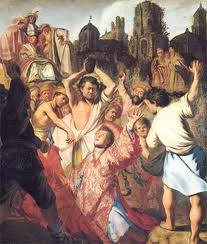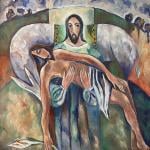“Happy Stoning Day!” Brother John said as he greeted me below the choir stalls after noon prayer. December 26 is the Feast of St. Stephen, officially designated as the first Christian martyr. Brother John, a guitar-picking, out-of-the-box product of the sixties, is not your typical Benedictine.  “I’ve always wanted to play Dylan’s ‘Everybody Must Get Stoned’ at mass on St. Stephen’s Day,” he said. My kind of monk—irreverence is my favorite virtue.
“I’ve always wanted to play Dylan’s ‘Everybody Must Get Stoned’ at mass on St. Stephen’s Day,” he said. My kind of monk—irreverence is my favorite virtue.
Stephen has always been a problem for me. Although Acts has been one of my favorite books of the Bible since childhood, with its exciting stories of early Christians acting just like imperfect and flawed human beings, regularly bailed out of tough circumstances by the Holy Spirit, I got uncomfortable when Stephen came up in church or Sunday School. Stephen died for Jesus, j ust like some missionaries in South America that we were always hearing about. “Would you die for Jesus, just like Stephen did?” the pastor or teacher would ask, to which I (internally) would definitively answer “Hell No!” Dying for Jesus ranked right up there with becoming a missionary to deepest, darkest Africa as things I definitely did NOT intend to do with my life. If being a good Christian meant being willing to die for Jesus, I thought, then maybe I should check out what they do at the Catholic church on the other, spiritually mysterious side of town.
ust like some missionaries in South America that we were always hearing about. “Would you die for Jesus, just like Stephen did?” the pastor or teacher would ask, to which I (internally) would definitively answer “Hell No!” Dying for Jesus ranked right up there with becoming a missionary to deepest, darkest Africa as things I definitely did NOT intend to do with my life. If being a good Christian meant being willing to die for Jesus, I thought, then maybe I should check out what they do at the Catholic church on the other, spiritually mysterious side of town.
Although I’m much more aware of it now, since I’ve been married to a cradle Catholic and have taught in Catholic institutions of higher education for the past two and a half decades, my still dominant Protestant sensibilities are occasionally jangled by the strong Catholic focus on saints and martyrdom.  Just a few years ago I burst out laughing when I stumbled across a very peculiar piece of artwork while looking around a little church in Boston’s North End. Peculiar in the sense that it was a statue of a demure young woman holding a plate with two eyeballs on it. “Oh yeah, that’s Saint Lucy,” Jeanne said in the same tone of voice with which she might have gestured in my direction and said “Oh yeah, that’s my husband” to an inquiring stranger
Just a few years ago I burst out laughing when I stumbled across a very peculiar piece of artwork while looking around a little church in Boston’s North End. Peculiar in the sense that it was a statue of a demure young woman holding a plate with two eyeballs on it. “Oh yeah, that’s Saint Lucy,” Jeanne said in the same tone of voice with which she might have gestured in my direction and said “Oh yeah, that’s my husband” to an inquiring stranger
Two Sundays ago—December 13—was Saint Lucy’s Day; this is important for a number of reasons, not the least of which is that Saint Lucy is the adopted saint of Sweden, the country of my ancestors on my mother’s side. For reasons about which I am not entirely clear, the celebrations and festivals commemorating the life and martyrdom of this third century Sicilian woman are most entrenched in Scandinavia—apparently the marauding Vikings carried her story back north with them after doing their part in bringing about the fall of the Roman Empire.  These celebrations are striking, including young ladies wearing wreaths of lighted candles on their head—something that strikes me as worthy of being reported to the safety authorities. Lucy’s story is indeed compelling; as is often the case in stories of martyrdom, she was exceedingly faithful to her beliefs a
These celebrations are striking, including young ladies wearing wreaths of lighted candles on their head—something that strikes me as worthy of being reported to the safety authorities. Lucy’s story is indeed compelling; as is often the case in stories of martyrdom, she was exceedingly faithful to her beliefs a nd suffered greatly before she died. As part of her suffering and torture her eyes were gouged out before she died; accordingly, she is the patron saint of blind people as well as of those who take care of our eyes. Which reminds me of a good friend who recently died.
nd suffered greatly before she died. As part of her suffering and torture her eyes were gouged out before she died; accordingly, she is the patron saint of blind people as well as of those who take care of our eyes. Which reminds me of a good friend who recently died.
Over the past few months three people I was close to have died. Ivan, with whom I formed a strong friendship during my last sabbatical, was in his seventies and died of a massive stroke during the summer. Matthew, a colleague with diabetes who regularly failed to take sufficient care of himself during the close to twenty years that I knew him, died of complications a couple of months ago.  Colene, a close friend of Jeanne’s and mine and one of the loveliest women I have ever known, died after a long and heroic fight against cancer a few weeks ago. The death of a friend is always difficult, but I’m particularly struggling with Colene’s passing.
Colene, a close friend of Jeanne’s and mine and one of the loveliest women I have ever known, died after a long and heroic fight against cancer a few weeks ago. The death of a friend is always difficult, but I’m particularly struggling with Colene’s passing.
Jeanne reminded me on Saint Lucy’s Day two weeks ago that Colene and Tom were married on Saint Lucy’s Day in 2009, a wedding so beautiful that I remember it as if it happened last week. Colene and Tom were not your typical love story—Colene had been married twice already and had five children, while Tom is a former Catholic priest. They met in Colene’s office—she was an ophthalmologist and he was one of her patients. Tom is one of Jeanne’s oldest friends, a relationship that predates Jeanne’s and mine by many years.  Colene and Tom had been together for a while when they decided to have a wedding; I’ll never forget when, during the time reserved for the bride to make comments and offer a toast at the wedding reception, Colene let the hundreds of people gathered in on a secret that only a few knew about—she said that she had cancer and probably only had a few months to live.
Colene and Tom had been together for a while when they decided to have a wedding; I’ll never forget when, during the time reserved for the bride to make comments and offer a toast at the wedding reception, Colene let the hundreds of people gathered in on a secret that only a few knew about—she said that she had cancer and probably only had a few months to live.
Those few months ended up being six years, but they were not easy ones. Tom and Colene’s love had to withstand not only her intense periods of illness but also problems from her previous marriage that never seemed to let up. She worked as an ophthalmologist and eye surgeon until shortly before she died; at her wake and funeral literally hundreds of people told Tom and her children about how she had changed their lives. Although we did not see each other often, Colene and I had a strong connection. For one thing, we were both extreme introverts married to out-of-control extroverts. We understood each other in the sort of way that only two introverts can, without words or fanfare but deep nonetheless. Colene was very rational by nature, as I am, and often struggled with the intuitive way in which her husband and others sometimes approached spiritual matters without much concern for logic. Although I have learned over the past few years to trust intuition more strongly than I ever have, I still appreciate it when things fit at least generally into a logical pattern—I resonate with Colene’s clinical mind.
Colene and I had a strong connection. For one thing, we were both extreme introverts married to out-of-control extroverts. We understood each other in the sort of way that only two introverts can, without words or fanfare but deep nonetheless. Colene was very rational by nature, as I am, and often struggled with the intuitive way in which her husband and others sometimes approached spiritual matters without much concern for logic. Although I have learned over the past few years to trust intuition more strongly than I ever have, I still appreciate it when things fit at least generally into a logical pattern—I resonate with Colene’s clinical mind.
People prayed for Colene’s healing until they were hoarse, and she died anyways. When visiting her grave with Tom a couple of weeks ago, he told Jeanne and me that although some might say that her passing was a “healing” of sorts in that it ended her pain and suffering, it was not the healing that she wanted. Or, I might add, the healing that her husband, her children, her friends, and her patients wanted. Colene was a modern Saint Lucy. She was a healer who literally brought light into darkness and caused the blind to see. She was an admirable tower of strength and resilience, and death had to work overtime to take her. Her passing left a huge hole in many people’s lives that will not be filled. But my guess is that Colene would not be pleased by an extended period of mourning. When a person of Colene’s character and beauty dies, we best remember her by being thankful for her all-too-brief presence in our lives and by finding ways to bring healing into our corners of the world, just as she did.












